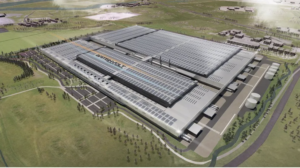Culture change
 As retail struggles, new models for our high streets are emerging. Ivan Tennant assesses some creative approaches to town centres.
As retail struggles, new models for our high streets are emerging. Ivan Tennant assesses some creative approaches to town centres.
The difficulty facing many high streets was highlighted with the appointment of Mary Portas to carry out an independent review earlier this year. On appointment, she said she wanted to identify what high streets should be ‘in the future’.
Many commentators, such as Jackie Sadek of UK Regeneration and Mike Riddell of Insite Asset Management, have urged her to look at greater investment in cultural amenities as part of her study. Plan Projects own research and the work we have been doing with private developers and local authorities alike similarly leads us to believe high streets’ core offer should not just be about shopping but delivery of an overarching experience that represents a strong and memorable cultural experience drawn from the values, traditions and identity of the place in question.
WHAT ARE HIGH STREETS FOR?
It is worth asking the question, what are our high streets for? Historically, it was the local hub where people came to trade. Over time, this activity has acquired a cultural dimension built on local practices and traditions. City centres have built up a fine stock of buildings, the area often peppered with cultural attractions that work in a symbiotic way with commercial activity and underpin civic pride and identity. As a result these places today can offer rich opportunities for social interaction, both planned and by chance, enjoyment of the built environment and a wide range of leisure activities.
For many consumers, these associated cultural motives have become the principal reason for visiting the high street as they have found other means to shop, for example, through the internet. The glove has therefore been turned inside out; what once seemed like an embellishment has become part of the core service and its quality essential to a high street’s prosperity.
 Cultural activity as a vital part of town centre prosperity is of course not new. PPS6, for example, encourages town centre managers to think in a culturally informed way. Forward thinking developers have for a long time recognised the importance of high quality public open space, making the most of heritage assets and running special events. However, the continual pressure on high streets and the closure of some multiples has forced us to think imaginatively about their renewal.
Cultural activity as a vital part of town centre prosperity is of course not new. PPS6, for example, encourages town centre managers to think in a culturally informed way. Forward thinking developers have for a long time recognised the importance of high quality public open space, making the most of heritage assets and running special events. However, the continual pressure on high streets and the closure of some multiples has forced us to think imaginatively about their renewal.
The clone town phenomenon gives a strong indication of where we have gone wrong. It arose through a short-term attitude to retail development and a failure of imagination at a strategic level. It has had a dramatic impact on the prosperity of towns as money is repatriated away from the local economy and specialist goods and services disappear to make way for an increasingly commoditised offer.
While large multiple retailers represent a vital part of the retail landscape, an approach that seeks to establish them regardless of location, context and identity is an example of placing short-term opportunity before long-term strategic advantage.
 CREATING THE MOSAIC EFFECT
CREATING THE MOSAIC EFFECT
An interesting model to embed both diversity and quality in the high street has been evolved by David Geddes for the consultancy Colliers. Seeing the city as a ‘mosaic’, they encourage breaking it down to ‘bite sized chunks’. This presents a picture of localised development that is appropriate to location as well as to the identity and resources available in that part of the town. It aims to deliver not just diversity of choice but also a means by which to help town centre managers recognise the value of smaller niche and independent retailers and how they can contribute to the overall picture of retailing in their town or city.
In an age where access to knowledge and a capacity on the part of people to influence tastes and trends exists as never before, those high streets that persist in offering poor, weakly differentiated choice will not prosper, notwithstanding the lavish promotional activity often seen when new shopping centres launch.
In taking this forward, the provisions within the new Localism Bill are helpful. Neighbourhood plans could be a means of creating the mosaic effect as clusters of like-minded retailers come together as ‘neighbourhood forums’ that reflect natural areas of economic activity. In many areas the institutional structures for these forums already exist, for example business improvement districts or, more at the level of the street, neighbourhood associations such as the Chancery Lane Association which is engaged with crafting a unique and specialised shopping experience in Chancery Lane.
FROM ECONOMICS TO ‘PLAY’
In leading edge places the adoption of these or similar policies is already apparent. The west end of London now has to compete with two major, purpose built shopping centres on its doorstep, Westfield White City and Westfield Stratford. The Oxford Regent Bond Action Plan and arts strategy developed by Plan Projects for the New West End Company and Westminster Council, seek to mobilise the area’s natural competitive advantages to retain its place as London’s premier retail destination.
First among these are resources that are cultural in nature, the presence of small pockets of public space that may be activated by creative use, the fine grain of its streets and the beauty of its buildings. This shifts the emphasis away from the purely economic towards one that reflects the value of social and environmental factors is driven both by changes in the competitive landscape and changes in consumer tastes, demands and behaviours.
 Evidence for this shift can also be seen in the kinds of businesses that thrive on the high street in today’s world. Capital & Counties in its Cultural Place-making study for Earls Court makes the observation that, confronted with online trade, high streets are finding a ‘new niche… with businesses that offer personal service (such as beauty salons, restaurants or hairdressers), and spectacle and community (such as galleries, craft workshops and pop-up shops)’ achieving greater prominence.
Evidence for this shift can also be seen in the kinds of businesses that thrive on the high street in today’s world. Capital & Counties in its Cultural Place-making study for Earls Court makes the observation that, confronted with online trade, high streets are finding a ‘new niche… with businesses that offer personal service (such as beauty salons, restaurants or hairdressers), and spectacle and community (such as galleries, craft workshops and pop-up shops)’ achieving greater prominence.
It is important to note these businesses offer not only a core service, but also contribute to the overall sense of the street as a place of play and recreation. Cities like Brighton have seen a similar trend, for example shops adopting a ‘shops as art’ practice, where the shop front is used to express not only their identity but also the passion of the founders for the products and services they sell. There are instances too of local government policy responding to these changes. Wycombe Council was selected as one of three councils to pilot ‘local development orders’. These permit a wider range of retail and service orientated uses than would otherwise be permitted in ‘historic but vulnerable’ town centre locations.
RESOURCES AS WELL AS VISION ARE NEEDED
There is, however, a key issue that is holding these places back. It is essential the local authority not only acts as a visionary steward of its high streets, but also has the resources with which to do so. It is hoped the community infrastructure levy, a portion of which must be spent locally, may create a pot of money on which cultural infrastructure projects may be taken forward. Also, a key finding of the City Finance Commission, which reported to government in May 2011, was that local authorities should be given greater control of their business rates should also be adopted. This too should result in strategies designed to revive high streets being given an increasing local character.
That footfall will be looking not
only to buy, but to participate and will expect to be inspired by the places they find.
Success in retailing is partly dependent on the presence of key groups of high spending consumers; these people are more likely to have a high level of both cultural and digital literacy. This means they are able to differentiate between those places with a true diversity and richness within their retail experience, and those that are more bland, unimaginative and commoditised.
The digital phenomenon can work both ways: just as people are more able to influence taste and be more demanding of those businesses they engage with, so it also allows retailers to explore different business models and means of promotion. It has been observed that the internet is not necessarily the enemy of the high street. Greater distribution through digital channels can lead to higher demand and consequently greater footfall. But that footfall will be looking not only to buy, but to participate and will expect to be inspired by the places they find.
- The pictures are of Whitstable high street, named the least cloned town in Britain in a recent survey by the New Economics Foundation













